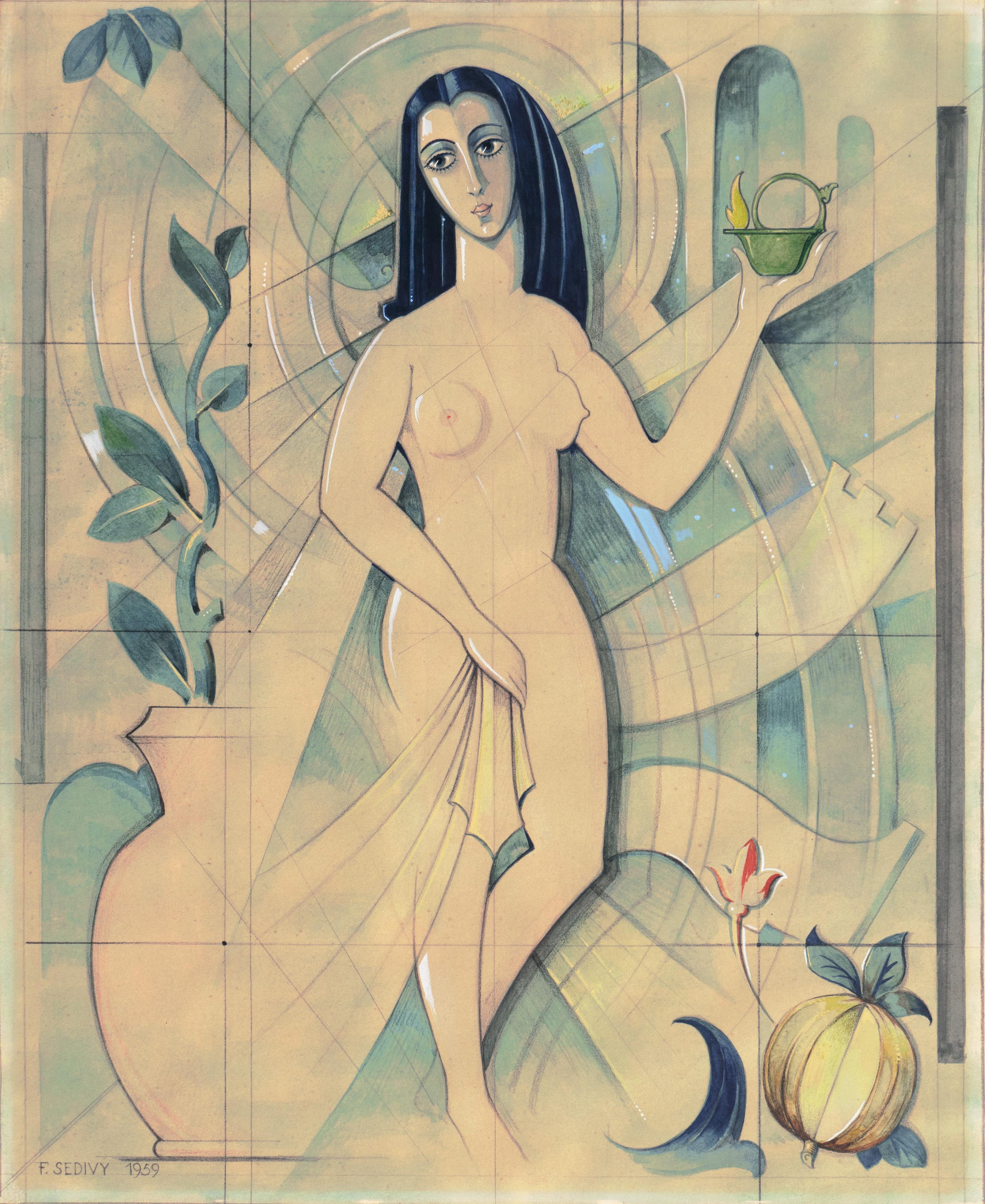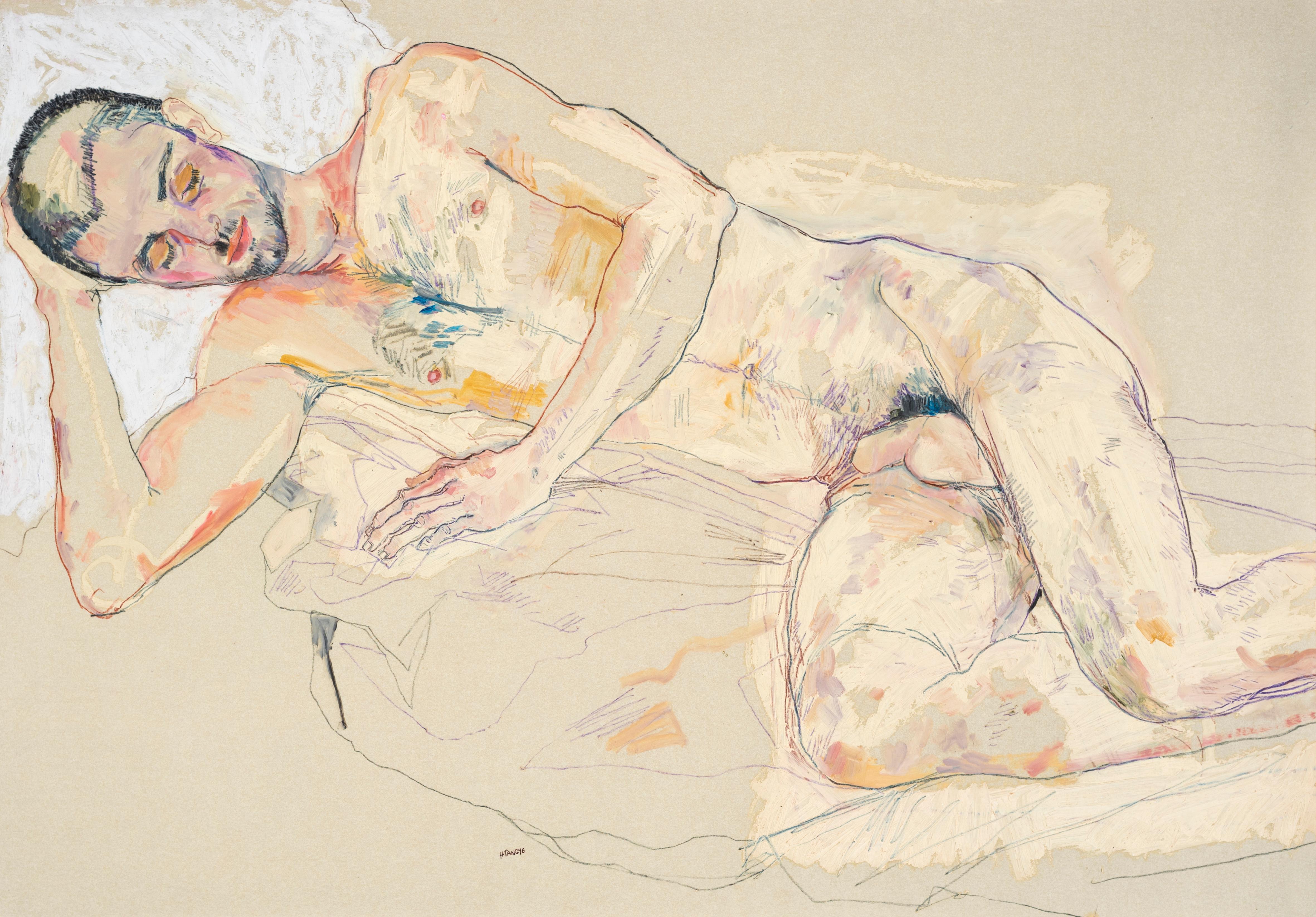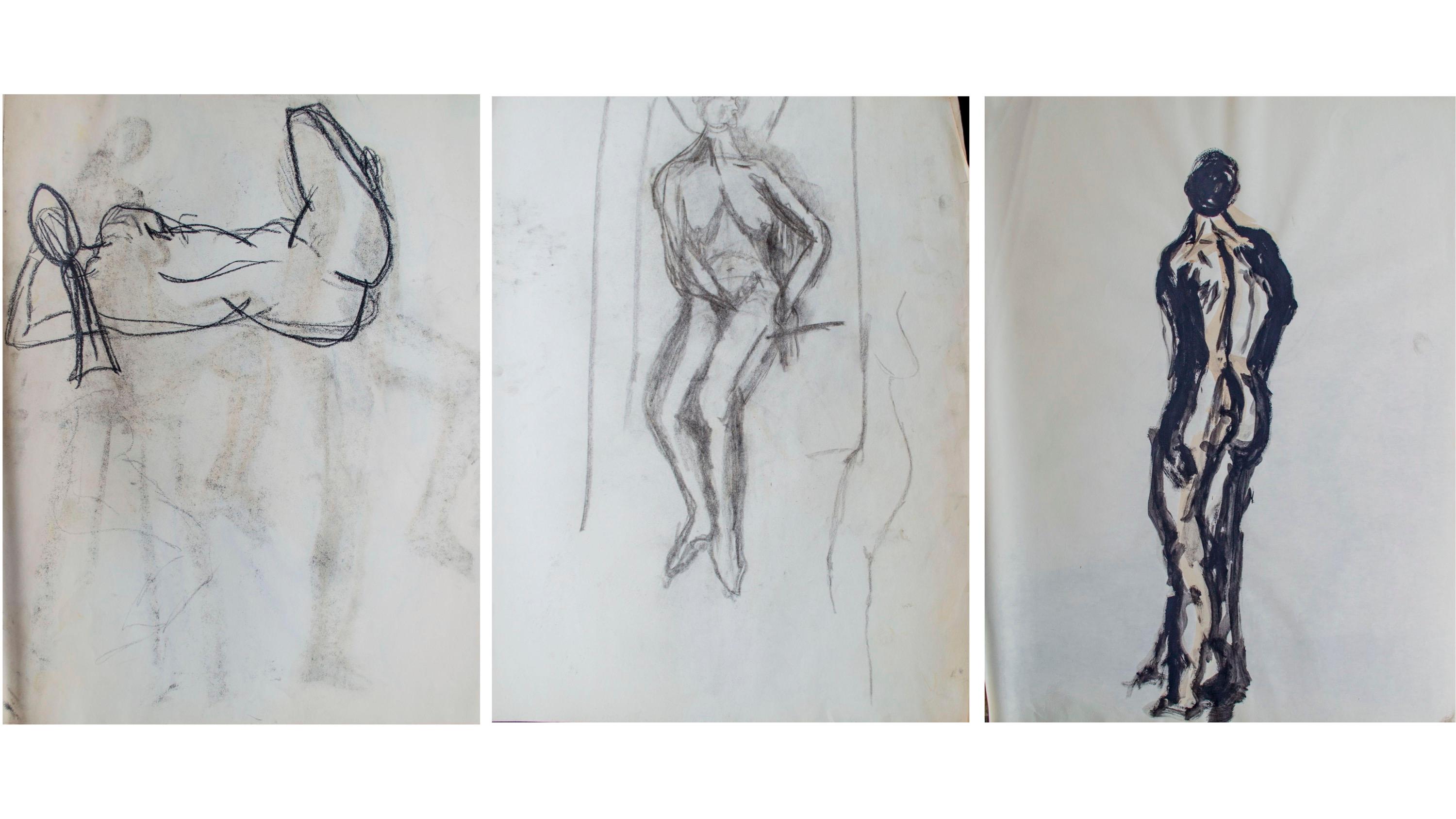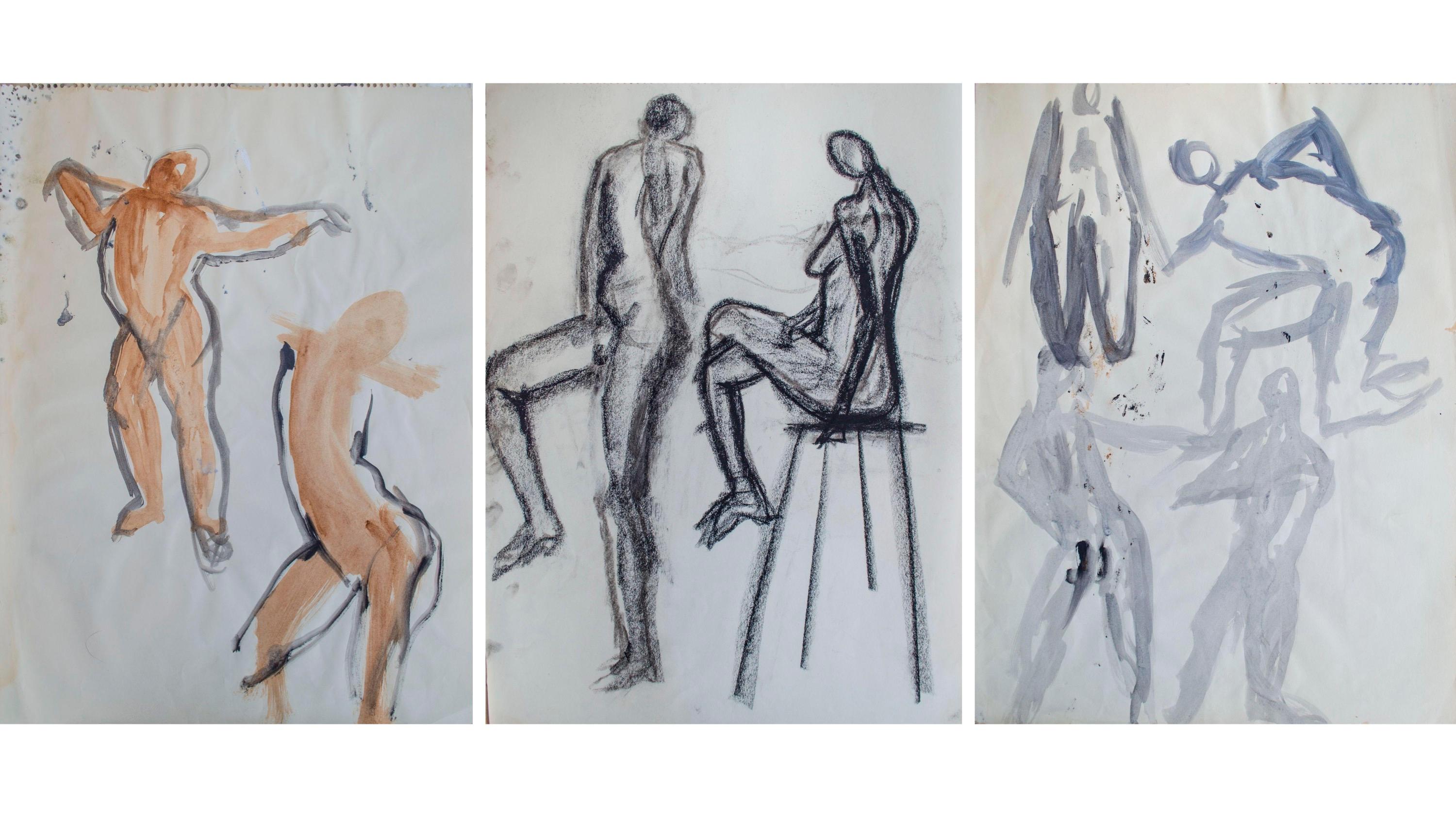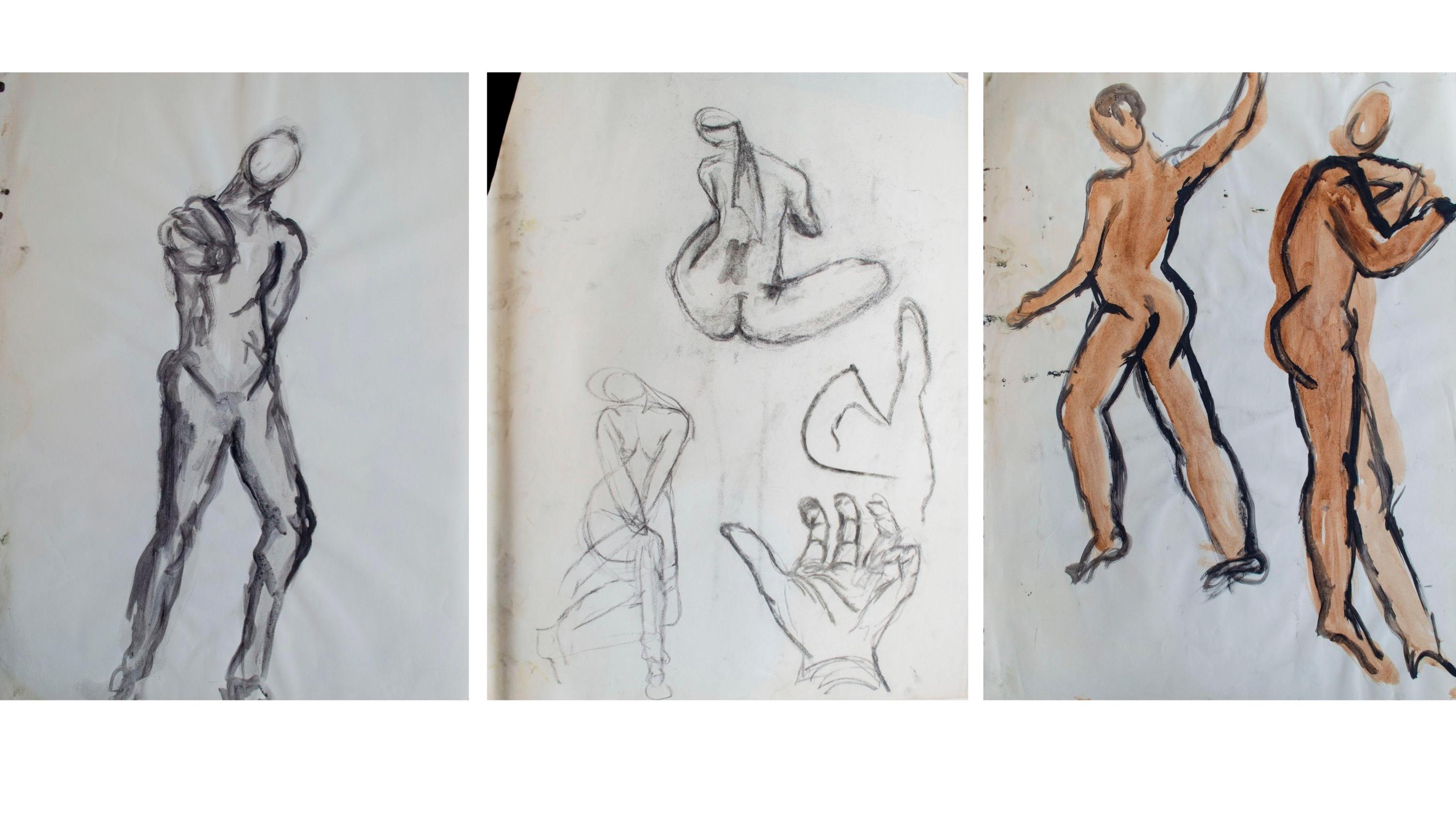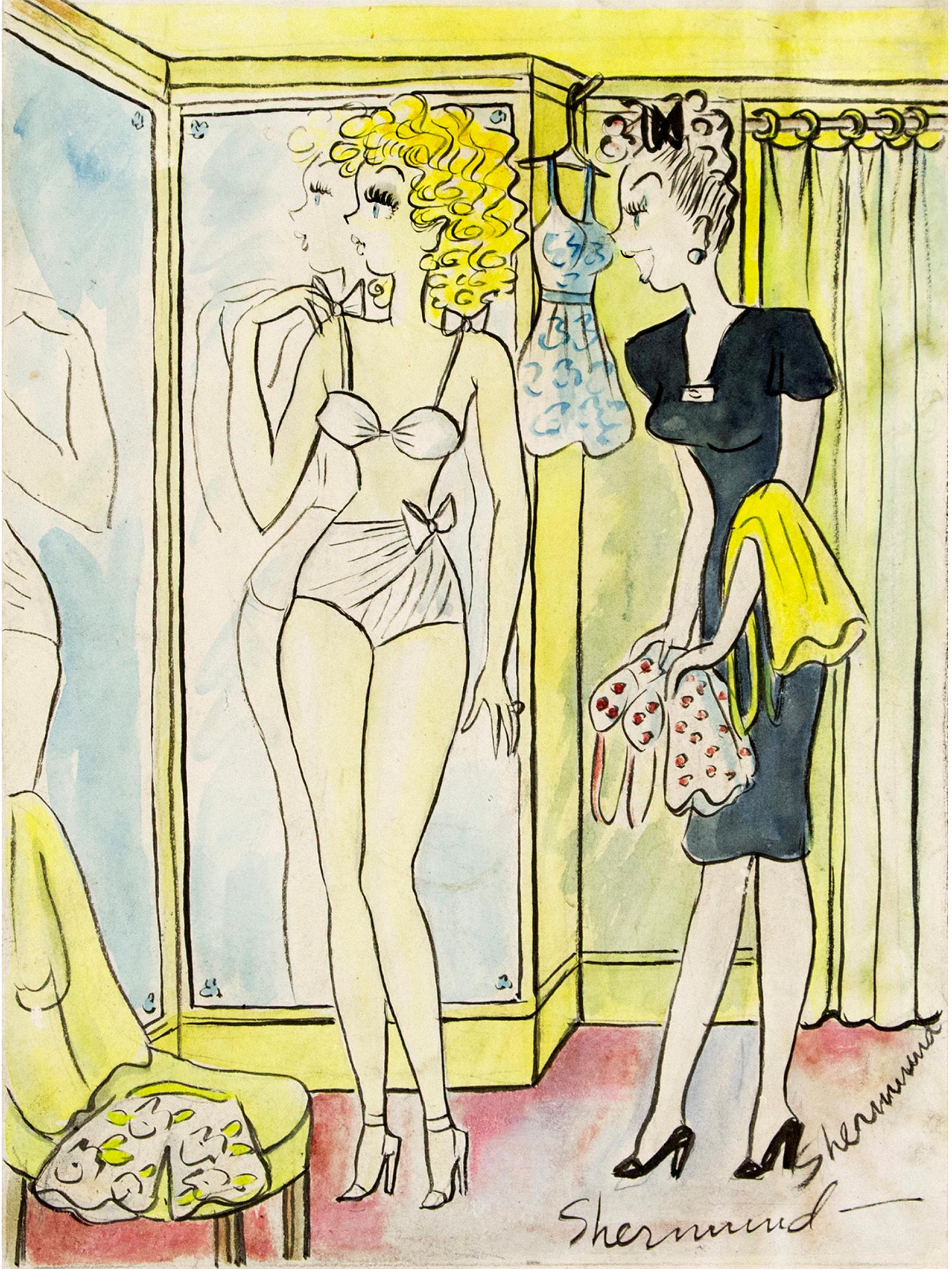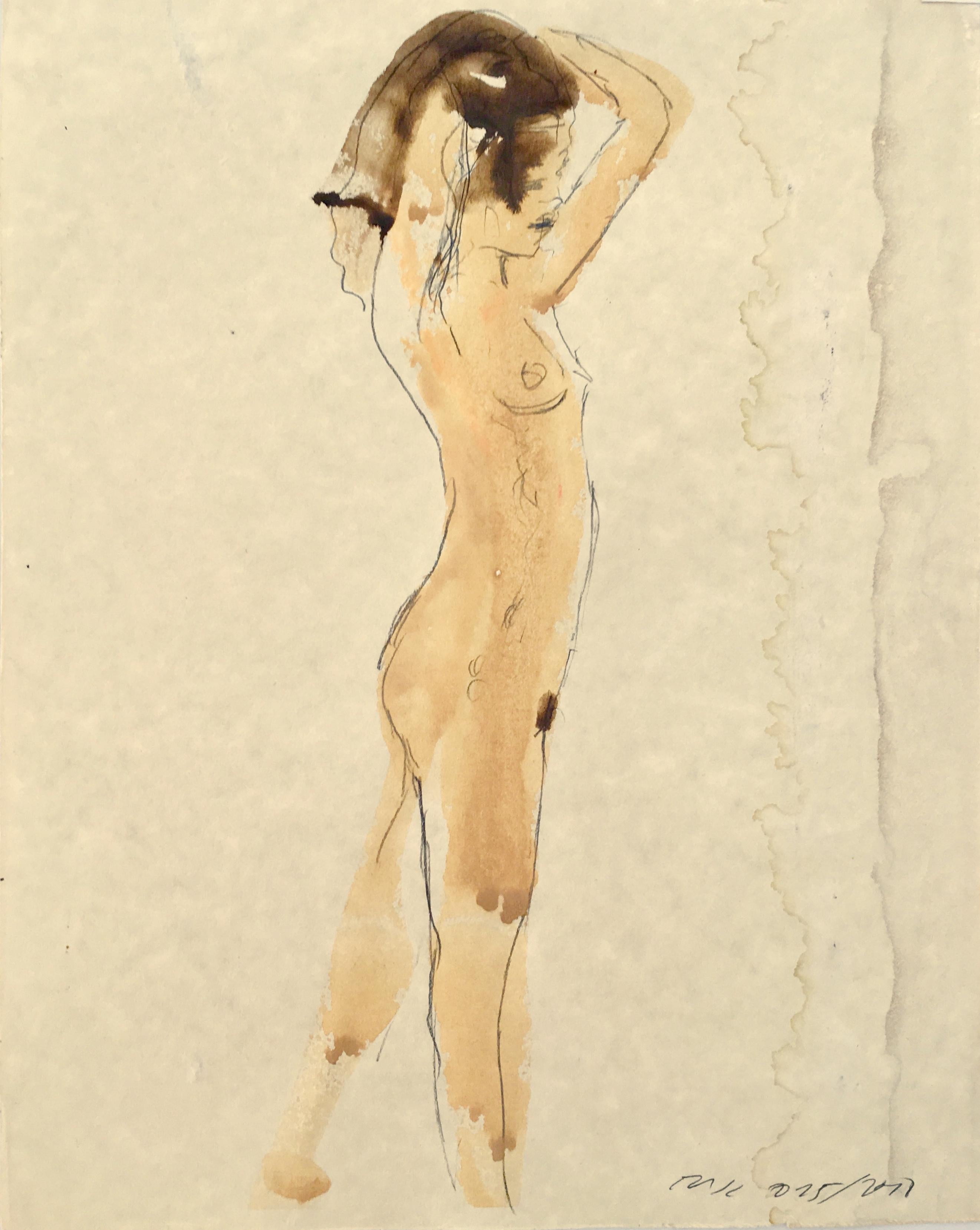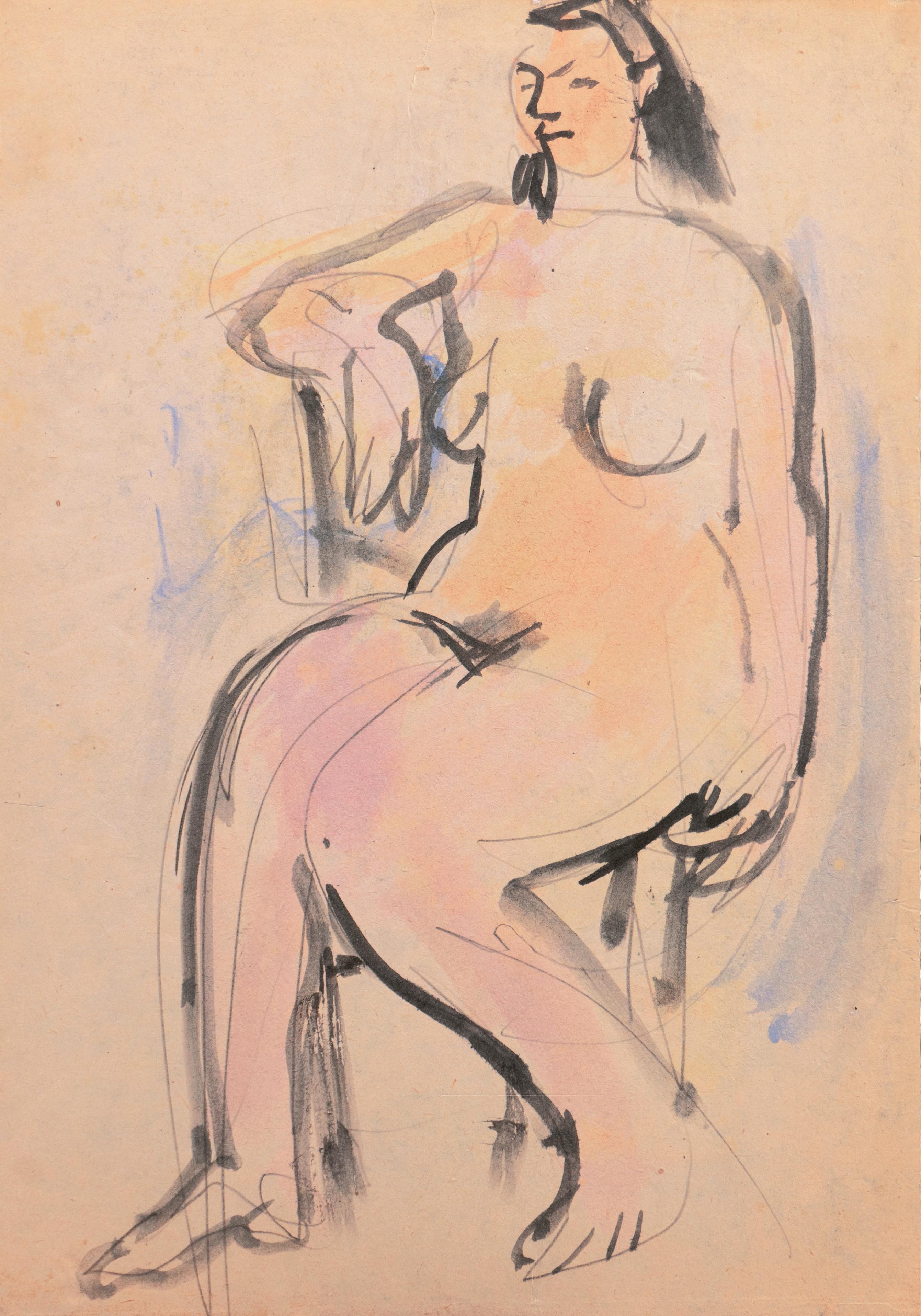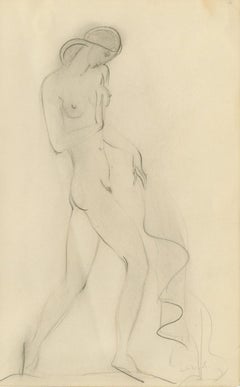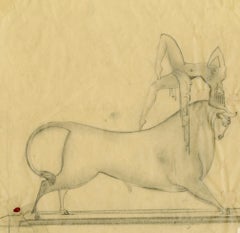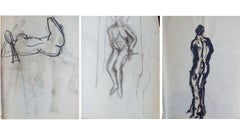
Seated Nude Model
View Similar Items
Want more images or videos?
Request additional images or videos from the seller
1 of 5
August F. BiehleSeated Nude Model1914
1914
About the Item
- Creator:August F. Biehle (1885 - 1979, American)
- Creation Year:1914
- Dimensions:Height: 14 in (35.56 cm)Width: 10 in (25.4 cm)
- Medium:
- Movement & Style:
- Period:
- Condition:
- Gallery Location:Fairlawn, OH
- Reference Number:Seller: FA81111stDibs: LU140106838
About the Seller
5.0
Recognized Seller
These prestigious sellers are industry leaders and represent the highest echelon for item quality and design.
Platinum Seller
These expertly vetted sellers are 1stDibs' most experienced sellers and are rated highest by our customers.
Established in 1978
1stDibs seller since 2013
711 sales on 1stDibs
Typical response time: 1 hour
Associations
International Fine Print Dealers Association
More From This SellerView All
- Untitled (Two Standing Nudes, one seated nude)By Boris Lovet-LorskiLocated in Fairlawn, OHUntitled (Two Standing Nudes, one seated nude) Graphite on wove paper, heightened with color, c. 1930 Unsigned From a sketchbook created while the artist was working in Paris Condition: Very good Provenance: Estate of the Artist Dawson's Auction, Morris Plains, NY, 2001 Boris Lovet-Lorski Lithuanian/Russian/American 1894-1973 Sculptor, painter, and printmaker, Boris Lovet-Lorski was born in Lithuania in 1894. His mother died when he was age three. His father was affluent and owned real estate. Boris grew up in a privileged environment. He studied architecture and then fine arts at the Imperial Academy of Art in Petrograd, Russia (now Saint Petersburg). Following the revolution in 1917 and its aftermath, Boris immigrated to Boston to live with his brother. In the 1920’s, his stylized, Art Deco inspired sculptures, lithographs, and paintings proved to be popular among the American elite. He exhibited frequently, holding his first solo exhibition in Boston, 1920. In the following years, Boris exhibited in New York at Marie Sterner Gallery, Jacques Seligmann Galleries and Wildenstein and Company. He lived in Paris from 1926 to 1932 where he befriended Joseph Hecht, and was exposed to the works of Pablo Picasso, Ossip Zadkine, Contantin Brancusi and Aristide Maillol. In 1932 he returned to America where he became a citizen later in the decade. Lovet-Lorski exhibited in the United States, South America, Europe and Asia. He was a member of the Society of Independent Artists (New York), the National Academy of Design (New York), and the Lotos Club (New York), as well as several Parisian salons. His work is in the permanent collections of numerous museums including the Musée Luxembourg, Bibliotèque Nationale, and the Petit Palais in France, the British Museum in London, the Metropolitan Museum in New York, the National Gallery in Washington, the Los Angeles County Museum of Art. (A more extensive list of his works in museums follows) He is considered one of the most successful and recognized sculptors of his generation. His creative influence can be seen in many of his contemporary artists. He died in Los Angeles in 1973. Regarding his iconic Art Deco sculptures of Cretan Dancers: “The stylizing of the Cretan allegories, used in figures of animals such as horses and bulls, symbolizes the ancient power of the South. These figures reveal a spiritual sensuality as he strives to attain a symbol of the earth and universe endowed with musical values. If man is the center of his idea of life and nature, it is because of the laws that govern the movement of stars and history. The link binding his figures together has, in a sense, a Pythagorean harmony.” Salvatore Quasimodo, Milan, 1967, quoted from Bush, Boris Lover-Lorski: The Language of Time, page 12. Lovet-Lorski created sculptures of the following major figures I.J. Paderewski, Prime Minister of Poland Arturo Toscanini, Italian Conductor Lilian Gish, Actress President Franklin D. Roosevelt Mrs. M. C. Niarchos, wife of Stavros Niarchos President Abraham Lincoln James Forrestal, Secretary of the Navy, First Secretary of Defense Pope Pius XII Dr. Albert Einstein, theoretical physicist President Dwight D. Eisenhower Albert Schweitzer, theologian, organist, writer, humanitarian, philosopher, and physician General Charles De Gaulle, President of the Fourth and Fifth Republic, France John Foster Dulles, Secretary of State, 1953-1959 President John F. Kennedy Works by Lover Lorski are in the following public collections: Albright-Knox Art Gallery, Buffalo Art Institute of Chicago Bibliotheque Nationale, Paris Brandeis University, Waltham, MA British Museum, London Boston University Brooklyn Museum California Palace of the Legion of Honor, Sam Francisco...Category
1930s Art Deco Nude Drawings and Watercolors
MaterialsGraphite
- Untitled (Standing Female Nude)By Boris Lovet-LorskiLocated in Fairlawn, OHUntitled (Standing Female Nude) Graphite on paper, c. 1930 Signed bottom right: Lorski (see photo) Sheet size: 9 5/16 x 5 13/16 inches From a sketchbook created while the artist was working in Paris Condition: Good Thin spots verso from previous mounting Soft vertical fold running across image Barely visible on recto Provenance: Estate of the Artist Dawson's Auctioneers and Appraisers, 2001 Amity Art Foundation Boris Lovet-Lorski Lithuanian/Russian/American 1894-1973 Sculptor, painter, and printmaker, Boris Lovet-Lorski was born in Lithuania in 1894. His mother died when he was age three. His father was affluent and owned real estate. Boris grew up in a privileged environment. He studied architecture and then fine arts at the Imperial Academy of Art in Petrograd, Russia (now Saint Petersburg). Following the revolution in 1917 and its aftermath, Boris immigrated to Boston to live with his brother. In the 1920’s, his stylized, Art Deco inspired sculptures, lithographs, and paintings proved to be popular among the American elite. He exhibited frequently, holding his first solo exhibition in Boston, 1920. In the following years, Boris exhibited in New York at Marie Sterner Gallery, Jacques Seligmann Galleries and Wildenstein and Company. He lived in Paris from 1926 to 1932 where he befriended Joseph Hecht, and was exposed to the works of Pablo Picasso, Ossip Zadkine, Contantin Brancusi and Aristide Maillol. In 1932 he returned to America where he became a citizen later in the decade. Lovet-Lorski exhibited in the United States, South America, Europe and Asia. He was a member of the Society of Independent Artists (New York), the National Academy of Design (New York), and the Lotos Club (New York), as well as several Parisian salons. His work is in the permanent collections of numerous museums including the Musée Luxembourg, Bibliotèque Nationale, and the Petit Palais in France, the British Museum in London, the Metropolitan Museum in New York, the National Gallery in Washington, the Los Angeles County Museum of Art. (A more extensive list of his works in museums follows) He is considered one of the most successful and recognized sculptors of his generation. His creative influence can be seen in many of his contemporary artists. He died in Los Angeles in 1973. Regarding his iconic Art Deco sculptures of Cretan Dancers: “The stylizing of the Cretan allegories, used in figures of animals such as horses and bulls, symbolizes the ancient power of the South. These figures reveal a spiritual sensuality as he strives to attain a symbol of the earth and universe endowed with musical values. If man is the center of his idea of life and nature, it is because of the laws that govern the movement of stars and history. The link binding his figures together has, in a sense, a Pythagorean harmony.” Salvatore Quasimodo, Milan, 1967, quoted from Bush, Boris Lover-Lorski: The Language of Time, page 12. Lovet-Lorski created sculptures of the following major figures I.J. Paderewski, Prime Minister of Poland Arturo Toscanini, Italian Conductor Lilian Gish, Actress President Franklin D. Roosevelt Mrs. M. C. Niarchos, wife of Stavros Niarchos President Abraham Lincoln James Forrestal, Secretary of the Navy, First Secretary of Defense Pope Pius XII Dr. Albert Einstein, theoretical physicist President Dwight D. Eisenhower Albert Schweitzer, theologian, organist, writer, humanitarian, philosopher, and physician General Charles De Gaulle, President of the Fourth and Fifth Republic, France John Foster Dulles, Secretary of State, 1953-1959 President John F. Kennedy Works by Lover Lorski are in the following public collections: Albright-Knox Art Gallery, Buffalo Art Institute of Chicago Bibliotheque Nationale, Paris Brandeis University, Waltham, MA British Museum, London Boston University Brooklyn Museum California Palace of the Legion of Honor, Sam Francisco...Category
15th Century and Earlier Art Deco Nude Drawings and Watercolors
MaterialsGraphite
- Preliminary Study for Cretan Dancer BronzeBy Boris Lovet-LorskiLocated in Fairlawn, OHPreliminary Study for Cretan Dancer Bronze Graphite on tracing paper, 1930 Unsigned Note: The bronze sculpture measures 24 1/2 x 33 5/8 inches and is signed and dated 1930 on the base (see image on right). It is currently being offered for sale by Taylor Graham Gallery in New York. (see photo) “The stylizing of the Cretan allegories, used in figures of animals such as horses and bulls, symbolizes the ancient power of the South. These figures reveal a spiritual sensuality as he strives to attain a symbol of the earth and universe endowed with musical values. If man is the center of his idea of life and nature, it is because of the laws that govern the movement of stars and history. The link binding his figures together has, in a sense, a Pythagorean harmony.” Salvatore Quasimodo, Milan, 1967, quoted from Bush, Boris Lover-Lorski: The Language of Time, page 12. Image size: 6 1/2 x 6 1/2 inches Condition: Repaired tear in the lower left corner (see detail photo) Boris Lovet-Lorski Lithuanian/Russian/American 1894-1973 Sculptor, painter, and printmaker, Boris Lovet-Lorski was born in Lithuania in 1894. His mother died when he was age three. His father was affluent and owned real estate. Boris grew up in a privileged environment. He studied architecture and then fine arts at the Imperial Academy of Art in Petrograd, Russia (now Saint Petersburg). Following the revolution in 1917 and its aftermath, Boris immigrated to Boston to live with his brother. In the 1920’s, his stylized, Art Deco inspired sculptures, lithographs, and paintings proved to be popular among the American elite. He exhibited frequently, holding his first solo exhibition in Boston, 1920. In the following years, Boris exhibited in New York at Marie Sterner Gallery, Jacques Seligmann Galleries and Wildenstein and Company. He lived in Paris from 1926 to 1932 where he befriended Joseph Hecht, and was exposed to the works of Pablo Picasso, Ossip Zadkine, Contantin Brancusi and Aristide Maillol. In 1932 he returned to America where he became a citizen later in the decade. Lovet-Lorski exhibited in the United States, South America, Europe and Asia. He was a member of the Society of Independent Artists (New York), the National Academy of Design (New York), and the Lotos Club (New York), as well as several Parisian salons. His work is in the permanent collections of numerous museums including the Musée Luxembourg, Bibliotèque Nationale, and the Petit Palais in France, the British Museum in London, the Metropolitan Museum in New York, the National Gallery in Washington, the Los Angeles County Museum of Art. (A more extensive list of his works in museums follows) He is considered one of the most successful and recognized sculptors of his generation. His creative influence can be seen in many of his contemporary artists. He died in Los Angeles in 1973. Regarding his iconic Art Deco sculptures of Cretan Dancers: “The stylizing of the Cretan allegories, used in figures of animals such as horses and bulls, symbolizes the ancient power of the South. These figures reveal a spiritual sensuality as he strives to attain a symbol of the earth and universe endowed with musical values. If man is the center of his idea of life and nature, it is because of the laws that govern the movement of stars and history. The link binding his figures together has, in a sense, a Pythagorean harmony.” Salvatore Quasimodo, Milan, 1967, quoted from Bush, Boris Lover-Lorski: The Language of Time, page 12. Lovet-Lorski created sculptures of the following major figures I.J. Paderewski, Prime Minister of Poland Arturo Toscanini, Italian Conductor Lilian Gish, Actress President Franklin D. Roosevelt Mrs. M. C. Niarchos, wife of Stavros Niarchos President Abraham Lincoln James Forrestal, Secretary of...Category
1930s Art Deco Nude Drawings and Watercolors
MaterialsGraphite
- Untitled Female NudeBy Steven AssaelLocated in Fairlawn, OHUntitled (Female Nude) Graphite and sgrafitto on yellow paper, 1987 Signed lower right Note: Steven Assael is represented by Forum Gallery in New York. In 1977 he won the Charles Ro...Category
1980s American Realist Nude Drawings and Watercolors
MaterialsGraphite
- Standing Male Nude, Arms Upraised (Kouros)By Gaston LachaiseLocated in Fairlawn, OHStanding Male Nude, Arms upraised (Kouros) Graphite on wove paper, c. 1930 Signed lower right (see photo) Possibly exhibited in May 8-June 1,1973 at Alan Stone Gallery entitled Eroti...Category
1930s American Modern Nude Drawings and Watercolors
MaterialsGraphite
- Preparatory drawing for Figure Composition, Carmel (CA.)By E. Ambrose WebsterLocated in Fairlawn, OHPreparatory drawing for Figure Composition, Carmel (CA) Graphite on paper, 1931 Signed with the artist's initial "W" lower right corner (see photo)...Category
1930s American Modern Nude Drawings and Watercolors
MaterialsGraphite
You May Also Like
- 'Vestal Virgin', Danish Modernism, Art Deco Figural, Mythological, Neo-classicalLocated in Santa Cruz, CASigned lower left, 'F. Sedivy' for Franz Sedivy II (Danish, 1888-1973) and dated 1959. A dramatic figural painting of a young woman, shown naked and holding aloft an earthenware oil...Category
1950s Art Deco Nude Drawings and Watercolors
MaterialsPaper, Watercolor, Gouache, Graphite
- Craig (Nude), Mixed media on Pergamenata parchmentBy Howard TangyeLocated in London, GBHoward Tangye (b.1948, Australia) has been an influential force in fashion for decades. Lecturing at London’s Central Saint Martins for 35 years, including 16 years as head of BA Wom...Category
2010s Contemporary Nude Paintings
MaterialsArchival Paper, Handmade Paper, Vellum, Pen, Pencil, Carbon Pencil, Gess...
$5,644 Sale Price27% Off - Ross Bleckner Group of 3 Double Sided Figure Drawings (attrb.)By Ross BlecknerLocated in Larchmont, NYAttributed to: Ross Bleckner (American, b. 1949) Group of 3 Double Sided Drawings Watercolor and graphite on paper Largest: 24 x 18 in. Smallest: 23 1/4 x 18 in. Ross Bleckner grew up in Hewlett, Long Island, New York; drawing all the time without being aware that other artists existed. He was the middle child between two sisters; his father manufactures electronic parts He attended New York University where Sol Lewitt, Chuck Close and others were his teachers. He graduated in 1972, then spent a year at the California Institute of Arts. His contacts in the next few years were very fortuitous; Sol Lewitt and Chuck Close, Carl Andre, David Salle, Julian Schnabel, etc. Bleckner is on the nervous side, beset by self-doubt, insomnia, and gloom. He is unpretentious, although he is bluntly handsome, with olive complexion, and a compact build. He is "10 percent that is superficial and 90 percent that has to do with the depths and that is threatened by living. He is a very complicated individual. He is a very, very morose, deeply feeling, hardworking artist- he takes a lot from within himself - but always, no matter how successful he is, he feels he is going to fall into those depths." 1 Bleckner first exhibited his work in New York in 1974. The following year he was given his first one-man show; he was included in the 1975 Whitney Biennial.. Since about 1985 has addressed many of his paintings to the subject of AIDS- both documenting it as a historical phenomenon and commemorating specific individuals who have died. Written and submitted by Jean Ershler Schatz, artist and researcher from Laguna Woods, California. Bio sourced from the Archives of askArt. Sources include: Ross Bleckner's Mood Indigo by Lisa Liebmann, in ARTnews, May 1993...Category
Late 20th Century Contemporary Figurative Drawings and Watercolors
MaterialsPaper, Watercolor, Graphite
- Group of 3 Figure Drawings by Attributed to Ross BlecknerBy Ross BlecknerLocated in Larchmont, NYAttributed to Ross Bleckner (American, b. 1949) Group of 3 Double Sided Drawings Watercolor and graphite on paper All approx. 24 x 18 in. Ross Bleckner grew up in Hewlett, Long Island, New York; drawing all the time without being aware that other artists existed. He was the middle child between two sisters; his father manufactures electronic parts He attended New York University where Sol Lewitt, Chuck Close and others were his teachers. He graduated in 1972, then spent a year at the California Institute of Arts. His contacts in the next few years were very fortuitous; Sol Lewitt and Chuck Close, Carl Andre, David Salle, Julian Schnabel, etc. Bleckner is on the nervous side, beset by self-doubt, insomnia, and gloom. He is unpretentious, although he is bluntly handsome, with olive complexion, and a compact build. He is "10 percent that is superficial and 90 percent that has to do with the depths and that is threatened by living. He is a very complicated individual. He is a very, very morose, deeply feeling, hardworking artist- he takes a lot from within himself - but always, no matter how successful he is, he feels he is going to fall into those depths." 1 Bleckner first exhibited his work in New York in 1974. The following year he was given his first one-man show; he was included in the 1975 Whitney Biennial.. Since about 1985 has addressed many of his paintings to the subject of AIDS- both documenting it as a historical phenomenon and commemorating specific individuals who have died. Written and submitted by Jean Ershler Schatz, artist and researcher from Laguna Woods, California. Bio sourced from the Archives of askArt. Sources include: Ross Bleckner's Mood Indigo by Lisa Liebmann, in ARTnews, May 1993...Category
Late 20th Century Contemporary Figurative Drawings and Watercolors
MaterialsPaper, Watercolor, Graphite
- Ross Bleckner Group of 3 Figure Drawings (attrb.)By Ross BlecknerLocated in Larchmont, NYAttributed to Ross Bleckner (American, b. 1949) Group of 3 Double Sided Drawings Watercolor and graphite on paper Largest: 24 x 18 in. Smallest: 22 3/4 x 18 in. Ross Bleckner grew up in Hewlett, Long Island, New York; drawing all the time without being aware that other artists existed. He was the middle child between two sisters; his father manufactures electronic parts He attended New York University where Sol Lewitt, Chuck Close and others were his teachers. He graduated in 1972, then spent a year at the California Institute of Arts. His contacts in the next few years were very fortuitous; Sol Lewitt and Chuck Close, Carl Andre, David Salle, Julian Schnabel, etc. Bleckner is on the nervous side, beset by self-doubt, insomnia, and gloom. He is unpretentious, although he is bluntly handsome, with olive complexion, and a compact build. He is "10 percent that is superficial and 90 percent that has to do with the depths and that is threatened by living. He is a very complicated individual. He is a very, very morose, deeply feeling, hardworking artist- he takes a lot from within himself - but always, no matter how successful he is, he feels he is going to fall into those depths." 1 Bleckner first exhibited his work in New York in 1974. The following year he was given his first one-man show; he was included in the 1975 Whitney Biennial.. Since about 1985 has addressed many of his paintings to the subject of AIDS- both documenting it as a historical phenomenon and commemorating specific individuals who have died. Written and submitted by Jean Ershler Schatz, artist and researcher from Laguna Woods, California. Bio sourced from the Archives of askArt. Sources include: Ross Bleckner's Mood Indigo by Lisa Liebmann, in ARTnews, May 1993...Category
Late 20th Century Contemporary Figurative Drawings and Watercolors
MaterialsWatercolor, Graphite, Paper
- Group of 3 Figure Drawings by Ross Bleckner (attrb.)By Ross BlecknerLocated in Larchmont, NYAttributed to Ross Bleckner (American, b. 1949) Group of 3 Double Sided Drawings Watercolor and graphite on paper Largest: 24 x 18 in. Smallest: 23 1/4 x 18 in. Ross Bleckner grew up in Hewlett, Long Island, New York; drawing all the time without being aware that other artists existed. He was the middle child between two sisters; his father manufactures electronic parts He attended New York University where Sol Lewitt, Chuck Close and others were his teachers. He graduated in 1972, then spent a year at the California Institute of Arts. His contacts in the next few years were very fortuitous; Sol Lewitt and Chuck Close, Carl Andre, David Salle, Julian Schnabel, etc. Bleckner is on the nervous side, beset by self-doubt, insomnia, and gloom. He is unpretentious, although he is bluntly handsome, with olive complexion, and a compact build. He is "10 percent that is superficial and 90 percent that has to do with the depths and that is threatened by living. He is a very complicated individual. He is a very, very morose, deeply feeling, hardworking artist- he takes a lot from within himself - but always, no matter how successful he is, he feels he is going to fall into those depths." 1 Bleckner first exhibited his work in New York in 1974. The following year he was given his first one-man show; he was included in the 1975 Whitney Biennial.. Since about 1985 has addressed many of his paintings to the subject of AIDS- both documenting it as a historical phenomenon and commemorating specific individuals who have died. Written and submitted by Jean Ershler Schatz, artist and researcher from Laguna Woods, California. Bio sourced from the Archives of askArt. Sources include: Ross Bleckner's Mood Indigo by Lisa Liebmann, in ARTnews, May 1993...Category
Late 20th Century Contemporary Figurative Drawings and Watercolors
MaterialsPaper, Watercolor, Graphite
Recently Viewed
View AllMore Ways To Browse
Nude Drawing Series
Female Nude Watercolor
Female Nude Watercolor Paintings
Midcentury Modern Nude Art
Nude Woman Watercolor
Nude Sketch Drawing
Nude Women Drawing
Women Nude Drawing
Nude Line Drawing
Nude Line Drawings
Line Drawings Line Drawings Nude
Line Drawing Nude
Drawings Of Nude Women
Female Nude Figure Drawings
Erotic Nude Paintings
Male Nude Drawings
Male Nuder Drawings
Male Nude Drawing
